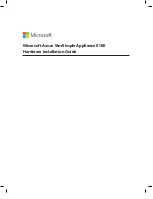
2-4
Cisco 10000 Series Router Software Configuration Guide
OL-2226-23
Chapter 2 Scalability and Performance
Scaling Enhancements in Cisco IOS Release 12.2(33)XNE
•
For SSG (RADIUS) configurations on PRE2, the following limitations apply:
–
For Cisco IOS Release 12.3(7)XI, ACLs defined through SSG configuration (RADIUS) are
restricted to mini-ACLs only. Turbo ACLs cannot be used in combination with SSG and
RADIUS. If you apply a Turbo ACL to an SSG session, the following syslog error is generated:
“%C10K_ACLS-3-SSG_TURBO_ACL: acl is a Turbo ACL and cannot be used for SSG.”
Note
If a mini-ACL is on the verge of becoming a turbo ACL (that is, the ACL contains eight
access control entries), SSG redirection can cause the mini-ACL to become a turbo ACL.
For Cisco IOS Release 12.3(7)XI, this change would also cause a syslog error to be
generated as follows: “%C10K_ACLS-3-SSG_ACL_ERR: acl is miniACL but cannot have
another punt rule added.”
•
The Cisco 10000 series router supports a maximum of 2,000 authentication, authorization, and
accounting (AAA) method lists. If you configure more than 2,000 AAA method lists by using the
aaa authentication ppp
or
aaa authorization
network
command, traceback messages appear on
the console.
•
To avoid CPU overload and router instability, use the
logging rate-limit
command to limit the rate
that the Cisco 10000 series router logs system messages. For more information, see the
logging
rate-limit
command in the
Cisco IOS Configuration Fundamentals and Network Management
Command Reference, Release 12.3
, located at the following URL:
http://www.cisco.com/en/US/products/sw/iosswrel/ps5187/products_command_reference_book09
186a008017d0a2.html
•
The Cisco 10000 series router high-speed interfaces work efficiently to spread traffic flows equally
over the queues. However, using single traffic streams in a laboratory environment might result in
less-than-expected performance. To ensure accurate test results, test the throughput of the Gigabit
Ethernet, OC-48 POS, or ATM uplink with multiple source or destination addresses. To determine
if traffic is being properly distributed, use the
show pxf cpu queue
command.
•
The Cisco 10000 series router supports a configuration file of up to 16 megabytes.
•
If you configure create on demand PVCs (individual and within a range) and PPP sessions, RP CPU
utilization can be extremely high when bringing up and tearing down sessions and PVCs. This usage
is a concern only when the configuration contains approximately 30,000 PPP sessions, and
additional services are enabled (such as DBS, ACLs, and service policies).
To reduce the RP CPU usage for PPPoA sessions, reduce the number of configured PVCs in a single
subinterface. To reduce the RP CPU usage for PPPoEoA sessions, use call admission control (
call
admission limit
command).
Scaling Enhancements in Cisco IOS Release 12.2(33)XNE
Starting from Cisco IOS Release 12.2(33)XNE, the
microcode reload pxf
command has been made for
general availability. When this command is executed in a scalable scenario, CPUHOG messages may
appear as the IOS software populates the parallel express forwarding (PXF) plane with the required
information to resume forwarding of traffic as soon as possible. If there is lot of information to be
populated, especially when the configuration is scaled up, CPUHOG messages may not appear till all
the information is populated.
















































